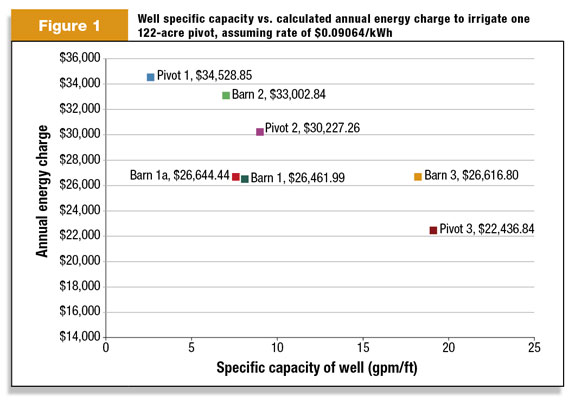In analyzing the cost to irrigate a crop or provide water to your barn, there are various factors that influence both short-term and long-term expense. All of the costs associated with pumping can be reduced by properly designing, constructing and testing the well. The most basic factor influencing short-term production cost is pumping head: The greater the pumping head, the higher the cost will be to pump the well. Pumping head can be divided into two categories: actual head (determined by the pumping water level in the well and the distance and elevation change to the field where the water will be applied) and artificial head.
Artificial head is created when the pump installed in the well is oversized for the desired production and has to be choked back using a valve at the surface to reduce flow, thereby creating artificial head. At a given flow rate every increase in head, whether caused by drawdown in the well or artificially increasing head at the ground surface, will result in increased horsepower demand by the pump and higher power use and cost.
While certain aspects of pumping head, such as the water table elevation and variations in ground surface elevation, cannot be controlled, other aspects such as well and pump efficiency can be significantly improved to the benefit of the producer during the well design, construction and testing phases.
Designing the well to have appropriately sized screens and filter pack sand (if necessary) and proper well screen locations will result in better well performance and less drawdown in the well.
Properly developing a well after drilling, using a variety of methods suitable for the particular well design, can result in significantly improved specific capacity. Development should continue until the well is sand-free and the specific capacity of the well is no longer increasing.
Specific capacity is measured as the amount of water that can be pumped per foot of drawdown in the well and is expressed as gallons per minute (gpm) per foot.

We have seen instances where the specific capacity of a well was improved by more than 50 percent during well development. To put this in perspective, Figure 1 uses data from actual wells at a dairy in Nevada to show the calculated annual cost to irrigate a 122-acre pivot at five acre-feet per acre and a power cost of $0.09064 per kilowatt hour.
In this example, the well with a specific capacity of 19.1 gpm per foot (Pivot 3) has a calculated annual pumping cost that is $7,904.42 lower than the well with a specific capacity of 9.0 gpm per foot (Pivot 2).
Added over a number of years and multiple pivots, this cost difference becomes very significant and demonstrates the importance of proper well design and development. A similar cost savings can be realized by properly testing the well after it is drilled and developed and before a permanent pump is installed.
Utilizing a test pump and a constant rate pumping test with a duration of four to seven days, the proper rate at which to pump the well for long-term production purposes can be determined. This allows your pump contractor to accurately and properly size the permanent production pump and eliminates the need to choke the well back at the surface.
A properly sized pump will operate at its optimal efficiency and can significantly reduce pumping costs.
In addition to the short-term costs savings that can be realized, there are significant long-term economic benefits to proper well design. Utilization of properly placed and sized well screens and filter pack sand in unconsolidated sand and gravel (rather than bedrock) aquifers will result in a well that does not produce sand during pumping.
Eliminating sand from the well prolongs the life of the pumping equipment, increases pump efficiency (because the impellers are not being worn by sand abrasion), and reduces the number of times a pump will need to be replaced over the life of the well.
Designing the well with screens located deep enough below the static water level so that they do not become dewatered during pumping also prolongs the life of both the pump and the well. As screens are dewatered, air can become entrained in the water being pumped, which may result in cavitation in the pump and, potentially, catastrophic failure of the pump.
Video logs conducted in wells that have experienced prolonged periods of pumping where the screens are consistently dewatered show that mineralization (encrustations on the screens) becomes concentrated in the zone that is consistently dewatered.
As the screens become mineralized, less water flows into the well, well efficiency declines and pumping costs increase. In areas where it is not possible to irrigate from a well without dewatering the screens (areas with limited saturated aquifer thickness), alternative well and pump designs can be implemented to reduce the impacts of dewatering the screens.
Taken over the expected life span of a well, the upfront costs associated with properly designing, constructing and testing the well are easily offset by the cost savings that can be achieved by reducing power costs and minimizing the frequency of pump and well replacement.
USDA-Rural Development currently has grant funds available for renewable energy systems and energy efficiency improvements under their Renewable Energy for America (REAP) program. Grants for energy efficiency improvements cover up to 25 percent of the costs up to $1,000,000 (grants up to $250,000).
Prior to receiving a grant, an Environmental Impact Report (EIR) needs to be completed. The EIR requires some time to complete, so applications should be submitted to USDA as soon as possible. PD
Riesterer has more than 11 years of experience designing and supervising the construction and testing of water supply wells for municipal, agricultural, commercial and domestic purposes. Riesterer is licensed as a professional geologist in Texas, Wyoming and Arizona.





